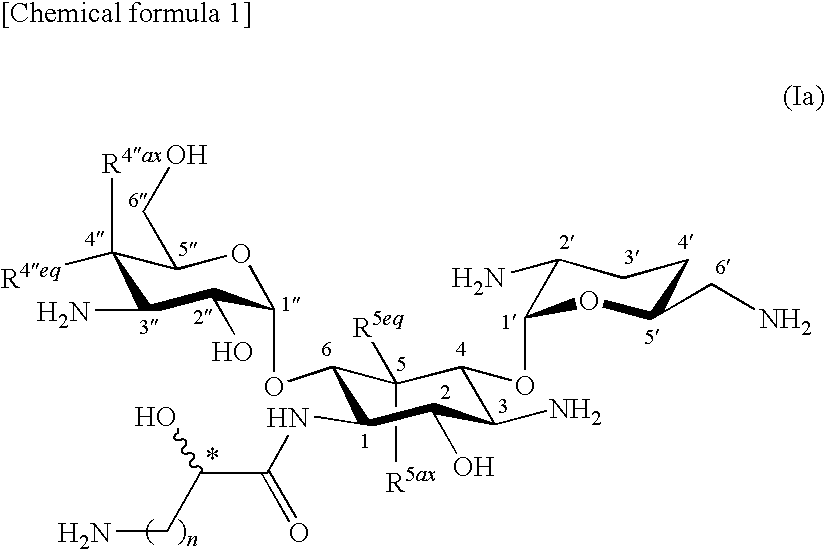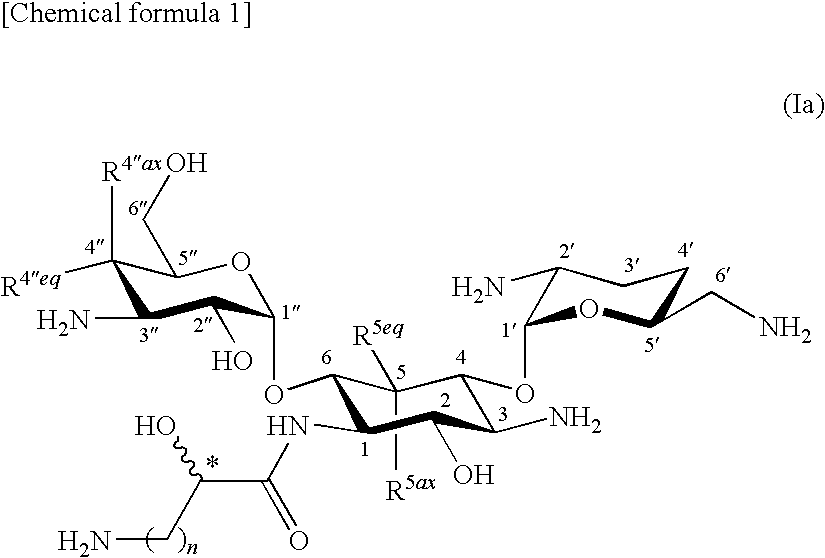Novel aminoglycoside antibiotics
- Summary
- Abstract
- Description
- Claims
- Application Information
AI Technical Summary
Benefits of technology
Problems solved by technology
Method used
Image
Examples
example 1
Production of 2-hydroxyarbekacin
[0527]
[0528]Production Step 1-1
Methyl 3-azido-3-deoxy-4,6-O-isopropylidene-D-glucopyranoside
[0529]
[0530]Methyl 3-azido-3-deoxy-D-glucopyranoside (32.7 g) synthesized according to the description of the method of C. B. Barlow et al. (J. Chem. Soc., Abstracts pp. 3870-3871, (June), (1965)) was dissolved in 330 mL of N,N-dimethylformamide. 2,2-Dimethoxypropane (26.8 mL) and 1.92 g of p-toluenesulfonic acid were added to the solution, and the mixture was stirred at 50° C. Three hr after the start of the stirring, 26.8 mL of 2,2-dimethoxypropane was further added to the reaction solution; after 5.5 hr, 2.10 g of p-toluenesulfonic acid was further added to the reaction solution; after 6.5 hr, 17.9 mL of 2,2-dimethoxypropane was further added to the reaction solution; and after 24 hr, 16.2 mL of triethylamine was added under ice cooling to the reaction solution, and the mixture was concentrated to dryness with a vacuum pump. Chloroform (1.5 L) was added to t...
example 2
2-Hydroxyarbekacin 2.5 sulfate Trihydrate
[0620]
[0621]The compound (2-hydroxyarbekacin; 126.8 mg) represented by formula (I) produced in production step 1-14 of Example 1 was brought to an aqueous solution. The aqueous solution was adjusted to pH 7.0 by the addition of 0.1 M sulfuric acid and was lyophilized to give 147.3 mg of 2.5 sulfate (trihydrate) of the title compound.
[0622]Calcd. for C22H44N6O11.2.5H2SO4.3H2O. C, 30.45; H, 6.39; N, 9.67.
[0623]Found, C, 30.41; H, 6.45; N, 9.46.
example 3
Production of 2-hydroxyarbekacin
[0624]
[0625]Production Step 3-1
1,3,2′,6′-Tetra-N-benzyloxycarbonyl-3′,4′-dideoxy-2-hydroxyneamine
[0626]
[0627]Process A: The compound (16.5 g, 38.3 mmol: calculated as dicarbonate) produced in production step 1-6 was dissolved in water (83 ml). Dimethoxyethane (165 ml) was added to the solution, and the mixture was then stirred. N-Benzyloxycarbonyloxysuccinimide (66.8 g, 268 mmol) was added thereto, triethylamine (56.0 ml, 402 mmol) was then added, and the mixture was stirred overnight (heat up to about 45° C. was generated). Ethyl acetate (490 ml) and water (83 mL) were added to the reaction solution followed by separation. The organic layer was washed with a saturated aqueous sodium hydrogencarbonate solution (247 mL) and a 10% aqueous sodium thiosulfate solution (247 mL) in that order. The organic layer was dried over anhydrous magnesium sulfate, was filtered, and was then concentrated under the reduced pressure. Methanol (133 ml) was added to the r...
PUM
| Property | Measurement | Unit |
|---|---|---|
| Composition | aaaaa | aaaaa |
| Antimicrobial properties | aaaaa | aaaaa |
Abstract
Description
Claims
Application Information
 Login to View More
Login to View More - R&D
- Intellectual Property
- Life Sciences
- Materials
- Tech Scout
- Unparalleled Data Quality
- Higher Quality Content
- 60% Fewer Hallucinations
Browse by: Latest US Patents, China's latest patents, Technical Efficacy Thesaurus, Application Domain, Technology Topic, Popular Technical Reports.
© 2025 PatSnap. All rights reserved.Legal|Privacy policy|Modern Slavery Act Transparency Statement|Sitemap|About US| Contact US: help@patsnap.com



